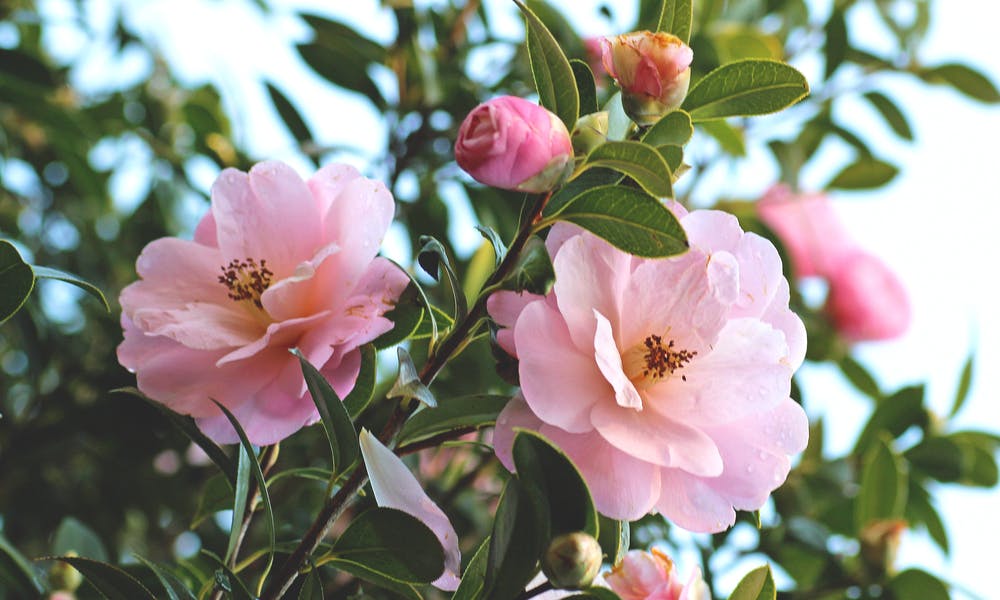Camellias bloom in mild climate zones from late fall to mid-spring bringing flowers to many dormant gardens. Because they grow in the winter months, camellias are a popular flower for holiday arrangements when many other flower varieties are not available. Their leaves can be used for tea and their seeds for unique cooking oil. The decorative and culinary possibilities are endless with this flower.
As you read this, you can learn the following:
* General Characteristics
* History
* Modern Meaning and Symbolism
* Care
* Creating Arrangements
General Characteristics
Camellia plants are hardy plants that are long-living and can bloom and grow for more than 100 years. The blooms of the camellia come in white, red, yellow, pink, and combinations of those colors. The flowers appear in a variety of shapes upright, round, and oval. Interestingly, the yellow bloom is only found in Vietnam and South China. In general, the flowers do not have a smell.
Camellias grow on average at a rate of 11 inches per year to an ultimate height from between 6 feet and 12 feet. When establishing the plants in your garden plan for plenty of space to accommodate their potential size specifically in width. In addition to gardens, Camellias can also be planted in containers that drain well and placed on patios. Camellias are non-toxic, which makes them a safe botanical choice around children.
History
The camellia was cultivated for hundreds of years in the Orient before its introduction to Europe. It was named after botanist, Georg Kamal. Selective breeding has enhanced the leaves of the camellia which have been used for tea for centuries. The seeds, as well as the leaves, are used in many kitchens. The seeds are pressed to make tea oil which is used as a seasoning and it is also used as a cooking oil. This oil is a go-to ingredient in many Chinese dishes as well as a medium for cleaning and protecting the blades of many cutting tools
Modern Meaning and Symbolism
Before Westernization, it was commonly believed in Japan that camellias were used by the gods as a shelter when they visited the earthly realm. It is associated with beheadings because the entire head of the flower drops off instead of petal by petal. To avoid bringing negative energy into the home the camellia is used more in gardens than as cut flowers.
Care
Camellias prefer a location in the garden that is partial to fully shaded. Generally, the red varieties are more tolerant to the sun than white varieties. Also, give your plants shelter from strong winds and adequate space to grow. Camellias require a copious amount of water either by rainfall or irrigation. To ensure the plants are receiving nutrients to support their needs, use a camellia specific fertilizer.
Creating Arrangements
Follow these steps for indoor arrangements designed from the garden’s flowers. First, cut the desired flower’s stem. Immediately, submerge the cut stem in water. Remove leaves from the stem that sit below the waterline. While the stem is still underwater, cut a 2-inch vertical slit at the end. Give the flowers time to sit in the water while you get the vase ready. Rinse the vase with tepid water and soap. Replace the soapy water with clean water and a cut flower preservative. Be sure to change the water every other day and trim the ends of the stems of your flowers with each water change.
You can also create a more formal arrangement, especially during the holidays. Follow the same steps for cutting your camellias. While they are sitting in the water, decide where you want your arrangement in your home. Some of the factors you need to consider are the height at which you are placing your arrangement. Putting it too high, such as on a shelf, prevents people from seeing all the flowers. If the arrangement is placed on a low service such as a coffee table or the dining room table, be sure the arrangement is short enough that it doesn’t block the view of people sitting across from each other. If the arrangement is against the wall, no flowers are needed in the back.
Once you have determined the location for your arrangement, have some fun finding a container. Think about antiques that never get used or that snowman cookie jar or a crystal bowl. Have fun and think from a different perspective. Also, collect small accents that add different visual interest points. Again, if it’s the holidays you can add small ornaments, berries, or candles. Because of the time of the year, consider adding freshly cut pine to your arrangement as well.
After you have gathered all the items you want to use in your arrangement, prepare the container for securing the flowers. There are three methods for preparing your vessel. You can use Oasis, a spongy brick of foam that is placed at the bottom of your container. Or you can apply a wire grid system to the top of your container. The final choice is to add gel beads to the bottom with some water.
Once you have a way to secure your arrangement, begin building your display. Add any greenery first, such as the pine boughs. Then place your camellias throughout the arrangement. Placing your camellias after the greenery makes it easier to replace any wilted flowers with new ones without disturbing the rest of the arrangement. Once the blooms are in place, add any accent items in and around the flowers.
Conclusion
Camellias add color and life to winter gardens and holiday arrangements. As they are the symbol of love, affection, admiration, and love, camellias are also the choice of many for weddings and bridal bouquets. Camellias add an elegant refinement to homes, gardens, and special occasions throughout the fall and winter season.
